Abstract
The authors have developed a personality scale to assess Tridoshas i.e. Vata, Pitta, and Kapha from psychological perspective in human beings. The Tridoshas are composed of the Pancha Mahabhutas, but one or the other Dosha is dominant singularly or in combination. There can never be a state when one or the other Pancha Mahabhutas and consequently the Tridoshas are absent totally. All five are essential to sustain life. Vata Dosha is composed of Akasa and Vayu Mahabhuta. Pitta Dosha is composed of Tejas or Agni and Ap Mahabhuta. Kapha Dosha is composed of Ap and Prithvi Mahabhuta. Although Tridosha is studied, understood, and applied in Ayurveda, the present authors have tried to validate the same from the domain of psychology. Since the authors are not from the domain of Ayurveda but of Psychology, there are some constructs that are not amenable for psychological testing which have been ignored. Only those constructs that can be used by psychologists to assess the psychological aspects of the Dosha Prakriti have been used to build items for the assessment of personality. In this process, the psychometric properties of the scale are established. The scale assesses the psychological manifestation of the Tridoshas, which was the basic objective. The standardization procedure involved in the development of the Mysore Psychological Tridosha Scale is herewith delineated.
Keywords: Ayurveda, Kapha, Pitta, personality assessment, psychometric scale, Tridosha, Vata
Introduction
One of the basic tenets of all systems of Indian philosophy is that man is a microcosm of the macrocosmic world that he inhabits. This implies explicitly that whatever man is made up of, the world too is made up of those same things or elements, but with different combinations and degrees. Here, by elements is meant the five Mahabhutas—that is Akasa, Vayu, Tejas, Ap, and Prithvi. The universe and man are made up of these five elements. In fact Ayurveda postulates that all living beings on the earth including the nonliving too are made up of these same five elements in varying degrees, specific to each form, matter, and species, and according to a predetermined ratio that cannot be changed. These five elements combine with each other to form the three humors of Vata, Pitta, and Kapha (also called as the Tridoshas in unison), which is the corner stone of Ayurvedic philosophy.[1–3]
The Tridoshas are composed of all the Pancha Mahabhutas, but one or the other is predominant, with the other four in lesser dominance. There can never be a state when one or the other Pancha Mahabhuta is absent totally. All five are essential to sustain life.
This paper is about the development of a scale to assess the psychological manifestation of personality based on the Tridoshas and classifies them accordingly. Here it is attempted to describe the outcomes of the test construction and the standardization of the scale based on the Tridoshas.
Each Dosha gives certain characteristic qualities to the person, based on which an individual can be classified as belonging to that particular Dosha type. Charaka and Sushruta recognize seven types or categories into which people can be classified, depending on the dominance of the Doshas in their body. They are said to belong to a particular Prakriti or Constitution, as follows:
People with dominant Vata (constitution or) Prakriti.
People with dominant Pitta Prakriti.
People with dominant Kapha Prakriti.
People with dominant Vata–Pitta Prakriti.
People with dominant Vata–Kapha Prakriti.
People with dominant Pitta–Kapha Prakriti.
People with balanced Doshas or with Vata–Pitta–Kapha Prakriti.
While, there are already some check lists/inventories based on Tridoshas, used to categorize people. These have been developed by Ayurvedists for use by Ayurvedic doctors for the purpose of Prakriti assessment and Dosha classification of patients. These were referred to for understanding the salient features that are most important for Prakriti classification from the Ayurvedic perspective. This is in addition to the Brhad Traayi (Charaka,[1] Sushruta,[2] and Vagbhata's[4] Samhitas) and the Laghu Trayi (Bhava Prakasa,[5] Yoga Ratnakara,[6] and Sharangadhara[7] Samhita) triads of texts that were consulted from the Ayurvedic domain of scriptural authorities.
The present authors are from the domain of Psychology, trying to develop a test to assess the personality of people from the Indian context of Tridoshas. Hence, those constructs like body build, hair color, skin texture, etc., which constitute the physical–physiological components are ignored. Hence this is a scale which assess the psychological aspects of the Tridoshas and classifies people accordingly. Hence it has been named as Mysore psychological Tridosha scale.
Review of the literature
There have been many papers which have discussed the relevance of the Ayurvedic theories and their interpretation and contribution to the study of psyche[8–11] from the psychological view point, both from the perspective of health and ill-health.
Attempts have been made to bring into public and scientific scrutiny the basic tenets of Ayurvedic physiology and its ramifications for modern understanding—again from the Ayurvedic viewpoint to bring home the implications for current understanding and future knowledge creation.[12–20] These studies deal with the Tridoshas and their actions on human behavior and how they contribute to mental health and ill health. They also study the dominance of the Tridoshas in ill health and give suggestions for their treatments.[21–23]
Other than the above mentioned tools, there have been many other tests developed from the Ayurvedic perspective to assess the Doshas. Most of them are checklist types of scales where the Ayurvedic doctor makes a tick mark against the trait exhibited by the patient. Finally the number of tick marks against each Dosha is tallied to give an indication of the dominance of the Doshas present in an individual. Though these checklists are available, they have not been standardized and none of the Ayurvedic doctors use these checklists to assess the Dosha–prakriti of an individual, preferring to orally ask questions and decide the Dosha–prakriti of the individual they are seeing. These cannot be used by psychologists though they may be used by mental health professionals to correlate items developed from the psychological domain with the pure Ayurvedic concepts and their assessment. These tests assess varied functions in people like genetic constitution[24] and psychosomatic constitution;[25–29] mental characteristics of a person;[30] body constitution of a person;[31] classification of human population based on HLA gene polymorphism which is based on the Prakriti concept according to Ayurveda;[32] a test has also been developed which establishes genetic basis for mind-body typologies based on Ayurvedic genomics;[33] whole genome expression and biochemical correlates of extreme constitutional types as defined in Ayurveda;[34] and mental constitution of cancer patients based on Ayurvedic concepts of the Trigunas.[35] The biochemical basis of the psychosomatic constitution has also been studied.[36]
There have been very few tests or tools that have been developed with psychometric properties for the assessment of the Doshas. One of which is a tool which studies individuals and associates it to occupational stress[37] wherein two tests—the DII and the DARSOF have been developed; the other assess Doshas according to Maharishi Ayurveda;[38] and the last is an empirical investigation of the effects of Maharishi Gandharva Veda music during live concerts.[39]
Keeping in view the above, the present authors have attempted to develop a scale to assess psychological perspectives of VPK as personality constructs in the Indian context. The details of the scale developed are as follows.
Development of the Mysore Tridosha scale
From many sources the characteristics necessary for the assessment of Deha Prakriti was collated and a list was made. From this list only those characteristics that were amenable for psychological assessment and observation were selected. Those constructs or characteristics which were not amenable for psychological testing were ignored and not taken into consideration. The constructs that were not taken into consideration for psychological assessments are as follows:
Descriptions of:
Body build, chest, calf, joints and gait, veins, and tendons.
Complexion and countenance.
Skin texture, wrinkling of skin, nails, hair texture, forehead, eyes, teeth, and eye-brows.
Perspiration and micturition, odor of body, mouth, armpit, and sweat.
Sexual potency.
Tremors.
The constructs that were taken into consideration to develop the items for the Tridosha scale are as follows:
Descriptions of:
Food habits, hunger, appetite, thirst, and digestion.
Dietary likings and taste preferences.
Liking for coldness, warmth, and tolerance to heat.
Fondness for flowers and garlands.
Courteous behavior.
Piousness and belief in God.
Courage and boldness.
Calmness of mind.
Grasping power, memory, intelligence, and concentration.
Speed of activities and movements, speed of speech.
Bowel movements.
Immunity to diseases and strength.
Sexual behavior.
Friendship.
Anger and fear.
Character.
Duration of sleep.
Hobbies.
Problem facing ability.
Exhibition of various behaviors.
Control over senses and desires.
Style of working.
Pattern of excitement.
These constructs that were amenable for psychological testing were identified and were delineated for each of the three Doshas from the Ayurvedic concepts and made into a tabular format and was shown to about 27 Ayurvedic doctors for their approval, to see if they felt that Deha Prakriti could be assessed by these factors, omitting the aforementioned six constructs. This is a scale which assesses the psychological aspect of the Tridoshas of Vata, Pitta, and Kapha and not the exact Deha Prakriti as specified in Ayurvedic texts which Ayurvedic doctors use to categorize people and administer medicines for disease manifestation. Their ratings are as follows:
Table 1 indicates that all (100%) the experts have agreed that these constructs can be used to measure Tridoshas (VPK). Hence, items were developed which assess these constructs for all the three Doshas and then was again shown to Ayurvedic experts for their opinion as to the assessing qualities of the items. Some items were identified as needing refinement. Those items were rephrased and refined and then shown to the experts and scholars to get their ratings which was the basis for developing the scale to assess personality of people based on Tridoshas (VPK scale).
Table 1.
Ratings of Ayurvedic experts for amenability of assessing Doshas from psychological perspective
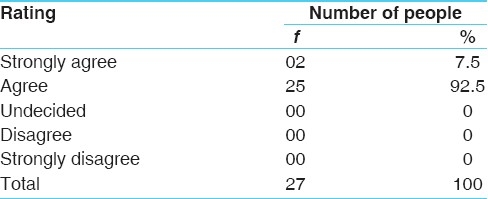
Sampling framework
The reliability measures of the Mysore Tridosha scale was established on a sample of 1548 respondents, and their breakup is as follows:
As can be seen in Table 2, the sample used for the development of the scale included 1548 respondents, which consisted of 358 teachers, 414 police, 346 IT professionals, and 430 people from the general adult category. The Mysore Tridosha scale was thus standardized on this sample, and results and inferences drawn therein.
Table 2.
Sample for the scale development

Criteria for inclusion and exclusion
The criteria followed for the inclusion of people's data into the final study and standardization of the scale was as follows.
Job satisfaction scale:[40] Only those people who had job satisfaction were included in the final analysis. Others were excluded.
Modified MINI:[41] This addresses basic Mental Health of the respondent and is relatively short with 22 questions. Data of people with only “No” answers for all the questions were taken into consideration.
The alcohol use disorders identification test (AUDIT):[42] This addresses drinking behavior. Scores up to 7 indicates Social Drinking which was accepted and included, while others were excluded.
The Fagerstrom Test for Nicotine Dependence (FTND):[43] This addresses smoking habits. Only nonsmokers were taken into consideration and included. Even low level of nicotine addiction as revealed by scores between 0 and 3 was also ignored and such data were not included.
Another criterion for inclusion into the study comprised people practicing in the profession for a minimum of 5 years consecutively.
Only those people who satisfied all the above mentioned criteria were taken for inclusion in the study, other data were not included for analysis.
An example of the kind of items included in the Mysore Tridosha scale:
Description of my behavior when I meet new people

The respondents were asked to tick the statement (1, 2, or all 3 if it is true of the respondents) that is most applicable to them, and also mark the degree to which it is present in them, making the respondents rate their own behavior in different situations. No triplet of answers could be ignored. Since software was developed for the purpose of the assessment of Personality, this could be controlled.
Establishing the Psychometric properties of the scale
The authors have developed and established the reliability, validity, and norms for the VPK scale as follows.
(a) Validity
Content validity was established by showing the items of the scale to Ayurvedic, Philosophy, and Sanskrit specialists and their concordances obtained. Wherever possible their suggestions to enhance the items were incorporated and the items were rephrased so as to elicit better responses.
Since there is no other tool/scale from the psychological domain to assess personality based on the Tridoshas, it was not possible to compare the present scale with any other to establish concurrent validity. Thus, only content validity was established.
After developing the items, some items were identified as needing refinement. Those items were rephrased and refined and then shown to the experts and scholars to get their rating which was the basis for developing the scale to assess personality of people based on Tridoshas (VPK Test). Table 3 indicates their responses.
Table 3.
Ratings of Ayurvedic experts of the Tridosha scale
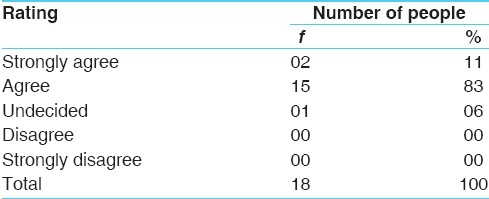
An analysis of the above table indicates that 94% of the experts have accepted that the items are assessing the Tridoshas. Thus the scale has a high level of content validity.
In the scale all constructs assessing similar traits were put into a cluster. The markings indicating the statements to be Vata, Pitta, or Kapha were removed. In each construct itself, the three statements were jumbled up so that there was no definite order of appearance of the three types of statements in all the construct wise questions. The scale comprised 52 statements to identify Vata, 52 statements to identify Pitta, and 53 statements to identify Kapha. The total number was thus 157, though subjects only see 51 sets of questions with triple statements each while answering. This comprised Level 1—Psychological manifestation of the physical–physiological assessment of people for the Personality assessment.
Simultaneously, psychologists were also consulted and requested to rate items for their amenability for assessment as psychological items based on the description given to them for each of the components of Vata, Pitta and Kapha. The responses are as follows [Table 4].
Table 4.
Ratings of psychologists on Tridosha (VPK) items
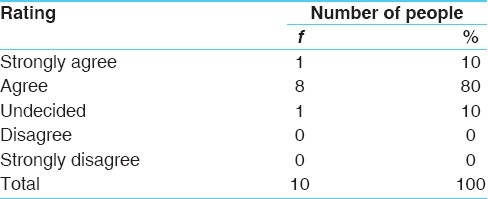
An analysis of the above table indicates that 90% of the psychologists have agreed that the items developed for assessing Tridosha do really assess Tridosha from psychological perspective. Hence, the scale has a high measure of content validity.
Since both the Ayurvedic specialists and psychologists have agreed that these items of VPK are measuring psychological aspects of VPK, the content validity of Tridosha scale can be said to have high validity.
(b) Reliability
The researchers have attempted to establish different possible types of reliability.
(i) Cronbach's α reliability analysis was conducted on the scale to establish its reliability properties. It was done for the sample of 407 individuals (initial scale), wherein the scale did not have the rating type of answers. A sample of 1548 individuals was used for the final scale, for which the reliability statistics was again conducted, wherein the scale was in the rating format. The Alpha indices for both the initial scale and the final scale are given below.
Table 5 also indicates that the same test when given as a Rating Scale performs better as compared to just a “Yes/No” pattern of answering. Hence the Rating Scale method is retained.
Table 5.
Reliability coefficients for VPK scale
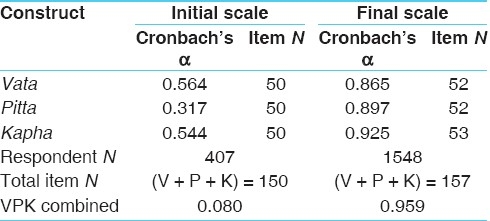
(ii) Split-half reliability statistical analysis was conducted on the scale to see if the first half of the scale behaves in the same fashion as the second half and to see if the respondents are answering the test properly or if they are just giving random answers. Since the scale does not have even number of question triplets, on division of the scale into half, Part 1 consisted of 79 items and Part 2 consisted of 78 items. The mean, variance, standard deviation of the two parts is indicated in Table 6.
Table 6.
Mean, variance and std. dev. of the scale

Cronbach's Alpha analysis on two parts of the scale was conducted to see if the Alpha indices of both parts of the scale are same or different which is another indicator for the reliability of the two parts of the scale. The results obtained are depicted in Table 7.
Table 7.
Reliability coefficients for the two parts of the scale
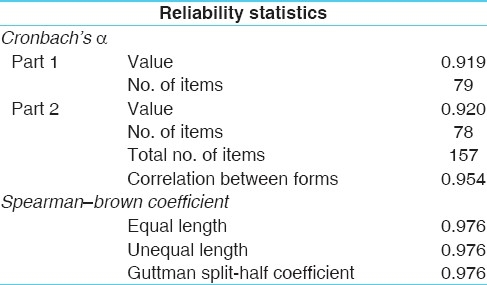
An analysis of the above table indicates that the split half reliability for the scale is very high as the obtained coefficient is very high, to the tune of 0.976.
(iii) Test–retest reliability of the scale was established by administering it to a group of 60 people with a gap of about 18-20 days from the first administration. The observation and results are indicated below [Table 8].
Table 8.
Test–retest reliability of the scale
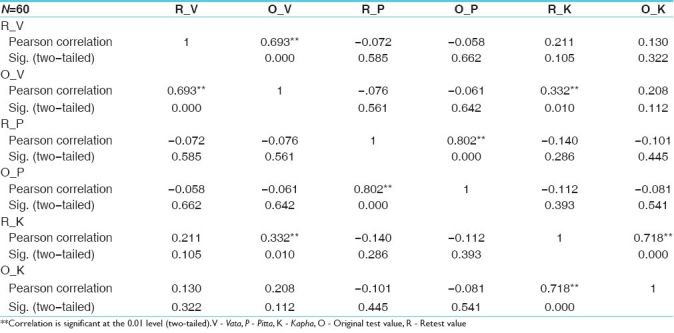
An analysis of the above table indicates that Vata, Pitta and Kapha have 0.693, 0.802, and 0.718 respectively, and all are significant at 0.01 level.
The salient characteristics for each of the three Doshas were developed and shown to Ayurvedic experts. Consensus from them was obtained and the characteristics were finalized thus (Refer to Table 1 in the beginning). The salient characteristics of the Tridoshas are indicated in Table 9.
Table 9.
Describing the salient characteristics of Tridoshas

Norms
The authors have developed Stanine scores[44] to convert raw scores to standard scores. The VPK raw scores data obtained from the total number of 1548 respondents was transformed to Stanine scores, and the transformation of scores is as follows, as represented in Table 10.
Table 10.
Transformation of VPK raw scores into Stanine scores

The scores on Vata Scale ranges from 0 to 156, the Pitta Scale ranges from 0 to 156, and that of Kapha Scale ranges from 0 to 159. These score ranges can be converted into Stanine scores using Table 10. Thus, an individual can be assessed on Vata, Pitta, and Kapha.
After conversion of the raw scores into Stanine scores, the data were analyzed to see the distribution of the scores and verify that it is a normal distribution. The results of analysis are shown in Table 11.
Table 11.
Distribution of scores after Stanine conversion
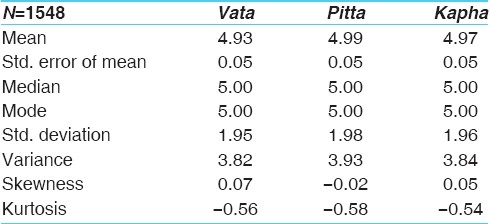
An analysis of the Table 11 indicates that the distribution of scores are closer to the normal probability curve, as all the measures of central tendency are very close to each other.
Discussion
The authors have studied the psychological manifestations of the Tridoshas in and on the psyche and developed this scale to assess the same, which comprises the development and standardization of the Mysore Tridosha Scale to assess personality on a large population of 1548 people. Tridosha scale is a self-rating scale, which has 157 items of the VPK (psychological correlates of the physical physiological traits as expressed by the Tridoshas of Vata, Pitta and Kapha), wherein there are 52 items for assessing Vata, 52 items for assessing Pitta and 53 items for assessing Kapha in an individual.
The items of the scale were shown to about 18 experts. Out of these 18 experts, 94% of the experts agreed that these items do measure VPK, while, 6% of them were undecided. The items that had objections from the Ayurvedic doctors were modified and showed to them again, after which their concordance for the same was obtained. The person who was undecided continued to be so even after many discussions and hence was retained as such. Thus, the items and the scale as a whole have high content validity. Since there are no other tests/scales available on VPK in psychology, the authors had no option but to establish only content validity. Thus, it was inferred that the items development was on the correct path.
The Cronbach's α for the three factors with the rating scale is as follows: 0.865 for Vata, 0.897 for Pitta, and 0.925 for Kapha and a combined VPK Cronbach's α of 0.959. This is indeed a high level of reliability measure.
The scale was administered to the individuals twice in the span of 18–20 days, to see the test-retest properties of the scale. The first administration is named as “Original Administration” and the second administration after a gap of 18–20 days is named as the “Retest Administration”. The answering pattern for the scale on both instances was analyzed. The Pearson correlation for Vata items was found to be 0.693, for Pitta items was found to be 0.802, and for Kapha items was found to be 0.718, all being positive and significant at the 0.01 level. Hence this proves that this scale is a reliable one.
On conducting the Split-Half reliability of the scale, the Mean for Part 1 was found to be 50.2190 and that of Part 2 was found to be 50.4671. The means of both Parts 1 and 2 are similar as also the variance and standard deviation, which indicates that the scale after being divided into two equal parts is behaving similar to each part. The first part of the scale is eliciting the same pattern of answers as the second part of the scale, thereby showing that the reliability of the scale is constant. This also indicates that respondents are not giving random answers, but are considering all the items and giving proper answers relevant to them and their behavior.
The α value for Part 1 was found to be 0.919 and that of Part 2 was 0.920. The correlation between forms was found to be 0.954. Spearman–Brown coefficient was applied and the value for equal length was found to be 0.976 and that of unequal length was found to be 0.976. The Guttman Split-Half coefficient was also computed and it was found to be 0.976. The Cronbach's α of both Parts 1 and 2 is similar while the correlation between forms is 0.954 which is also a high index of reliability. The Spearman–Brown coefficient of both equal length and unequal length is the same as that of the Guttman Split-Half coefficient constant. This also indicates that respondents are not giving random answers, but are considering all the items and giving proper answers relevant to them and their behavior. This indicates that the Cronbach's α coefficient of both parts is the same thereby reinforcing the reliability of the scale.
Conclusion
The authors conclude that they have been able to develop a scale to assess Vata, Pitta, and Kapha–the concepts taken from Ayurveda and validated in psychology using psychometric procedures. The developed scale has satisfactory reliability and validity indices. Thus, it could be used to assess psychological manifestations of Vata, Pitta, and Kapha among human beings.
References
- 1.Sharma P, translator. Charaka Samhita. Delhi: Chaukhambha Orientalia; 1981. pp. 1–4. [Google Scholar]
- 2.Sharma P, translator. Susruta Samhita. Varanasi: Chaukhambha Visvabharati; 2004. pp. 1–3. [Google Scholar]
- 3.Murthy KR, translator. Susruta Samhita. 1.3rd Ed. Varanasi: Chaukhambha Orientalia; 2007. [Google Scholar]
- 4.Murthy KR, translator. Vagbhata's Astanga Hrdayam. 3rd ed. 1. Varanasi: Krishnadas Academy; 1996. [Google Scholar]
- 5.Murthy KR, translator. Bhavaprakasa of Bhavamisra. Varanasi: Chowkhamba Krishnadas Academy; 2008. [Google Scholar]
- 6.Shetty M, Babu S, editors. Yoga Ratnakara. Varanasi: Chowkhamba Sanskrit Series Office; 2005. [Google Scholar]
- 7.Murthy PH, translator. Sarngadhara Samhita of Sarngadharacarya. 2nd ed. Varanasi: Chowkhamba Sanskrit Series Office; 2007. [Google Scholar]
- 8.Balodhi JP. Constituting the outlines of a philosophy of Ayurveda: Mainly on mental health import. Indian J Psychiatry. 1987;29:127–31. [PMC free article] [PubMed] [Google Scholar]
- 9.Reddy NG, Ramu MG, Venkataram BS. Concept of manas (psyche) in Ayurveda. NIMHANS Journal. 1987;5:125–31. [Google Scholar]
- 10.Balodhi JP. Classical Indian approaches to psychological dysfunction. In: Rao K. Ramakrishna, Marwaha Sonali Bhatt., editors. Towards a spiritual psychology. New Delhi: Samvad India Foundation; 2005. pp. 337–44. [Google Scholar]
- 11.Kapur M. Psychological Theories and Practices in Ayurveda. In: Rao K Ramakrishna, Paranjpe AC, Dalal AK., editors. Handbook of Indian Psychology. New Delhi: Cambridge University Press India Pvt. Ltd; 2008. pp. 299–312. [Google Scholar]
- 12.Hankey A. Ayurvedic physiology and etiology: Ayurvedo Amritanaam.The Doshas and their functioning in terms of contemporary biology and physical chemistry. J Altern Complement Med. 2001;7:567–74. doi: 10.1089/10755530152639792. [DOI] [PubMed] [Google Scholar]
- 13.Hankey A. The scientific value of Ayurveda. J Altern Complement Med. 2005a;11:221–5. doi: 10.1089/acm.2005.11.221. [DOI] [PubMed] [Google Scholar]
- 14.Hankey A. A test of the systems analysis underlying the scientific theory of Ayurveda's Tridosha. J Altern Complement Med. 2005b;11:385–90. doi: 10.1089/acm.2005.11.385. [DOI] [PubMed] [Google Scholar]
- 15.Hankey A. Dosha vikriti, Ayurveda's holistic system of etiology: A means to combat the global crisis in chronic disease. Plenary paper presented at IGCC conferenc. 2008 [Google Scholar]
- 16.Hankey A. Establishing the scientific validity of Tridosha. Unpublished paper, personal communication. 2008 Sep [Google Scholar]
- 17.Dwivedi CB. Ayurvedic concepts of the Purusa, dehaprakrti and Sattvaprakrti. In: Misra G, Mohanty Ajit K., editors. Perspectives on indigenous psychology. New Delhi: Concept Publishing Company; 2002. pp. 305–25. [Google Scholar]
- 18.Joshi RR. A bio-statistical approach to Ayurveda: Quantifying the Tridosha. J Altern Complement Med. 2004;10:879–89. doi: 10.1089/acm.2004.10.879. [DOI] [PubMed] [Google Scholar]
- 19.Lyssenko V. The human body composition in statics and dynamics: Ayurveda and the philosophical schools of Vaisesika and Samkhya. J Indian Philos. 2004;32:31–56. [Google Scholar]
- 20.Dilipkumar KV, Vaidyaratnam VP. Ayurvedic perspective of psychotherapy. Paper presented at National Seminar on Indian Psychology Theories and Models. Bangalore: Swami Vivekananda Yoga Anusandhana Samsthana; 2007. [Google Scholar]
- 21.Dube KC, Kumar A, Dube S. Personality types in Ayurveda. Am J Chin Med. 1983;11:25–34. doi: 10.1142/S0192415X83000069. [DOI] [PubMed] [Google Scholar]
- 22.Rao VA. Mind in Ayurveda. Indian J Psychiatry. 2002a;44:201–11. [PMC free article] [PubMed] [Google Scholar]
- 23.Rao VA. ‘Mind’ in Indian Philosophy. Indian J Psychiatry. 2002b;44:315–25. [PMC free article] [PubMed] [Google Scholar]
- 24.Prasad BS, Rao BC, Kumar GP. Assessment of Deha Prakriti (Genetic constitution)—Anthropometric measurements. 2004 [Google Scholar]
- 25.Singh RH, Singh MB, Udupa KN. J R Asiat Soc. Vol. 1. New Delhi: CCRAS; 1980. A study of Tridosha as Neurohumors; pp. 1–20. [Google Scholar]
- 26.Chandola HM, Tripathi SN, Udupa KN. Diabetes Mellitus – Prameha: The role of psychosomatic constitution (Prakriti) in the progression and prognosis of disease and response of treatment, Ph.D, thesis: I. M. S. Varanasi: BHU; 1984. [Google Scholar]
- 27.Chandola HM, Tripathi SN, Udupa KN. Alternative Medicine. Vol. 1. The Netherlands: VNU science press; 1985. The role of psychosomatic constitution (prakriti) in the progression and prognosis of Diabetes mellitus and response to treatment; pp. 141–54. [Google Scholar]
- 28.Dahanukar S, Thatte UM. “Ayurveda Unravelled”. New Delhi: National Book Trust; 2003. [Google Scholar]
- 29.Baghel AS, Dwivedi RR. Fundamental and applied study of Prakriti and its influence on Profession vice-a-versa. PhD thesis submitted to IPGT and RA. Jamnagar: Gujarat Ayurved University; 2004. [Google Scholar]
- 30.Vaidya V. Manasika Prasna Maalika with respect to aahara vihaara vichara. Unpublished M.Sc. thesis submitted to SVYASA University. 2006 [Google Scholar]
- 31.Mangala S. Deha patra prashna Maalika. (Check list of body constitution) Unpublished M.Sc. thesis submitted to SVYASA University. 2006 [Google Scholar]
- 32.Patwardhan B, Joshi K. Chopra A.Classification of human population based on HLA Gene polymorphism and the concept of Prakriti in Ayurveda. J Altern Complement Med. 2005a;11:349–53. doi: 10.1089/acm.2005.11.349. [DOI] [PubMed] [Google Scholar]
- 33.Patwardhan B, Bodeker G. Ayurvedic genomics: Establishing a genetic basis for mind-body typologies. J Altern Complement Med. 2008;14:571–6. doi: 10.1089/acm.2007.0515. [DOI] [PubMed] [Google Scholar]
- 34.Prasher B, Negi S, Aggarwal S, Mandal AK, Sethi TP, Deshmukh SR, et al. Whole genome expression and biochemical correlates of extreme constitutional types defined in Ayurveda. J Transl Med. 2008;6:48. doi: 10.1186/1479-5876-6-48. [DOI] [PMC free article] [PubMed] [Google Scholar]
- 35.Tripathi I, Pandey R. Mansik prakriti of cancer patients: An empirical study. Ayurveda and Mental Health. 2005 [Google Scholar]
- 36.Udupa KN, Singh RH, Dubey GP, Rai V, Singh MB. Biochemical basis of psychosomatic constitution. Indian J Med Res. 1975;63:923–7. [PubMed] [Google Scholar]
- 37.Glickman IL. The relationship between Maharishi Ayurvedic Dosha types and Ayurvedic environmental aggravation on occupational stress. Dissertation Abstracts International: Section B: The Sciences and Engineering. 1998;58(11-B):6234. [Google Scholar]
- 38.Olson TM. A Questionnaire to Study Maharishi Ayur- Veda. Complement Health Pract Rev. 1999;5:163–72. [Google Scholar]
- 39.Olson TM, Sorflaten JW. Empirical investigation of the effects of Maharishi Gandharva Veda music during live concerts. J Soc Behav Pers. 2005;17:571–88. [Google Scholar]
- 40.Singh A, Sharma TR. Job Satisfaction Scale. Agra: National Psychological Corporation; 1999. [Google Scholar]
- 41.Sheehan DV, Lecrubier Y, Sheehan KH, Amorim P, Janavs J, Weiller E, et al. The M.I.N.I. (Mini International Neuropsychiatric Interview). The Development and Validation of a Structured Diagnostic Psychiatric Interview. J Clin Psychiatry. 1998;59(Suppl 20):22–33. quiz 34-57. [PubMed] [Google Scholar]
- 42.Babor TF, Higgins-Biddle JC, Saunders JB, Monteiro MG. (World Health Organization, 2001: Department of Mental Health and Substance Dependence) The Alcohol Use Disorders Identification Test (AUDIT) [Google Scholar]
- 43.Heatherton TF, Kozlowski LT, Frecker RC, Fagerstrom KO. The Fagerstrom Test for Nicotine Dependence: A revision of the Fagerstrom Tolerance Questionnaire. Br J Addict. 1991;86:1119–27. doi: 10.1111/j.1360-0443.1991.tb01879.x. [DOI] [PubMed] [Google Scholar]
- 44.Ferguson GA. Statistical analysis in Psychology and Education. 5th Ed. New York: McGraw Hill International Publication; 1981. p. 458. [Google Scholar]


